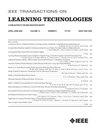从发现到设计和实施:将沉浸式技术融入公共安全培训的指南
IF 4.9
3区 教育学
Q2 COMPUTER SCIENCE, INTERDISCIPLINARY APPLICATIONS
引用次数: 0
摘要
沉浸式扩展现实(XR)技术,包括增强现实(AR)、虚拟现实和混合现实,正在通过促进技能习得和增强记忆的体验改变教育和培训的格局。这些技术显著提高了公共安全培训中的决策能力和态势感知能力。尽管有这些进步的希望,但在应急响应中采用XR的速度很慢。这种犹豫可以部分归因于缺乏将这些新技术整合到现有课程中的指导。这项工作旨在指导教学设计师、课程开发人员和技术人员将沉浸式技术无缝地整合到公共安全培训课程中。这项工作全面介绍了我们与教学设计师、公共安全人员和主题专家合作,为大规模伤亡事件(MCIs)中使用的分类、评估、救生干预、治疗/运输分诊技术开发基于ar的培训课程。此外,基于分析、设计、开发、实施、评估的教学设计模式,提出了公共安全课程开发的系统框架。利用以人为本的设计方法,我们首先分析了沉浸式学习在公共安全中的必要性。接下来,我们确定开发XR培训经验的障碍,并通过基于利益相关者反馈的迭代评估概述我们的培训原型构建。最后,我们通过对在AR中执行MCI分诊任务的消防员和紧急医疗技术人员的反复评估,并辅以调查问卷和半结构化访谈,分享定性见解。我们的目标是为将沉浸式技术成功整合到公共安全培训课程中提供蓝图。本文章由计算机程序翻译,如有差异,请以英文原文为准。
From Discovery to Design and Implementation: A Guide on Integrating Immersive Technologies in Public Safety Training
Immersive extended reality (XR) technologies, including augmented reality (AR), virtual reality, and mixed reality, are transforming the landscape of education and training through experiences that promote skill acquisition and enhance memory retention. These technologies have notably improved decision making and situational awareness in public safety training. Despite the promise of these advancements, XR adoption for emergency response has been slow. This hesitancy can be partially attributed to a lack of guidance for integrating these novel technologies into existing curricula. This work aims to guide instructional designers, curriculum developers, and technologists in seamlessly integrating immersive technologies into public safety training curricula. This work provides a comprehensive account of our collaboration with instructional designers, public safety personnel, and subject matter experts in developing an AR-based training curriculum for the Sort, Assess, Life-saving Interventions, Treatment/Transport triage technique used in mass casualty incidents (MCIs). In addition, we introduce a systematic framework for public safety curriculum development based on the Analyze, Design, Develop, Implement, Evaluate instructional design model. Leveraging a human-centered design approach, we first analyze the necessity for immersive learning in public safety. Next, we identify the obstacles in developing XR training experiences and outline our construct of a training prototype through iterative evaluations based on stakeholder feedback. Finally, we share qualitative insights through iterative evaluations with firefighters and emergency medical technicians performing MCI triage tasks in AR, supplemented by survey questionnaires and semistructured interviews. Our goal is to provide a blueprint for a successful integration of immersive technologies into public safety training curricula.
求助全文
通过发布文献求助,成功后即可免费获取论文全文。
去求助
来源期刊

IEEE Transactions on Learning Technologies
COMPUTER SCIENCE, INTERDISCIPLINARY APPLICATIONS-
CiteScore
7.50
自引率
5.40%
发文量
82
审稿时长
>12 weeks
期刊介绍:
The IEEE Transactions on Learning Technologies covers all advances in learning technologies and their applications, including but not limited to the following topics: innovative online learning systems; intelligent tutors; educational games; simulation systems for education and training; collaborative learning tools; learning with mobile devices; wearable devices and interfaces for learning; personalized and adaptive learning systems; tools for formative and summative assessment; tools for learning analytics and educational data mining; ontologies for learning systems; standards and web services that support learning; authoring tools for learning materials; computer support for peer tutoring; learning via computer-mediated inquiry, field, and lab work; social learning techniques; social networks and infrastructures for learning and knowledge sharing; and creation and management of learning objects.
 求助内容:
求助内容: 应助结果提醒方式:
应助结果提醒方式:


